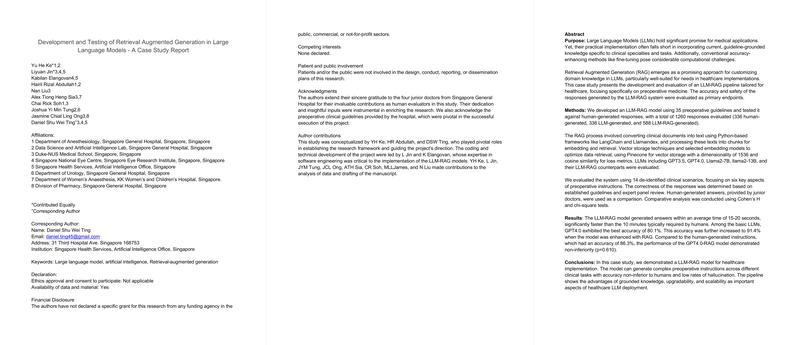Overview of LLM-RAG Model Development
In the exploration of LLMs for healthcare applications, particularly within the domain of preoperative medicine, the Retrieval Augmented Generation (RAG) presents a novel solution, as detailed in a comprehensive case paper report. The paper examined the efficacy of an LLM-RAG model, assessing its performance in generating accurate and practical preoperative instructions, benchmarked against human counterparts.
Methodology
The development process involved embedding 35 preoperative guidelines into an LLM-RAG framework. A total of 1260 responses were analyzed across different modalities, comparing human-generated instructions with those produced by baseline LLMs and their RAG-augmented versions. A sophisticated Python-based text conversion approach was employed to tailor these clinical guidelines for compatibility with the RAG framework. In terms of embeddings, models such as OpenAI's text-embedding-ada-002 were used in conjunction with cloud-based vector storage solutions like Pinecone. The RAG retrieval was managed by a customized Retrieval Agent that harnesses the stored vectors to find the most pertinent chunks of knowledge in relation to user queries.
Efficacy Outcomes
The results demonstrated powerful performance attributes of the LLM-RAG models. The enhanced GPT4.0-RAG model in particular exhibited the highest accuracy rate at 91.4%, whilst requiring a mere 15-20 seconds to generate responses—dramatically outspeeding the traditional 10-minute timeframe associated with human effort. Additionally, this model showcased comparable results to human practitioners, with an accuracy rate non-inferior at a p-value of 0.610. The efficiency and scalability of the LLM-RAG deployment in healthcare environments are further highlighted by these findings.
Conclusion and Implications
The investigations conclude that the integration of domain-specific knowledge through RAG can significantly boost LLM capacities within subspecialty healthcare domains. It offers a speed advantage while maintaining accuracy parity with human professionals. The LLM-RAG model, particularly based on GPT4.0, aligns with the priorities of modern healthcare—rapid, reliable, and scalable solutions for delivering patient care. The paper suggests that when applied judiciously, tailored LLM-RAG systems have the potential to augment human expertise effectively, promoting consistency and reducing the subjective variability in preoperative assessments.
Future Perspectives
Despite the promising outcomes, the authors also recognize certain constraints, emphasizing the need for periodic updates to the model as medical literature evolves. They propose a cautious implementation of such AI systems, complementing human expertise rather than substituting it. This is especially crucial given ethical considerations and potential biases inherent in AI deployment within clinical settings. The need for a benchmarked evaluation framework for RAG-LLM models in clinical applications is also identified as an essential step forward for the field.
